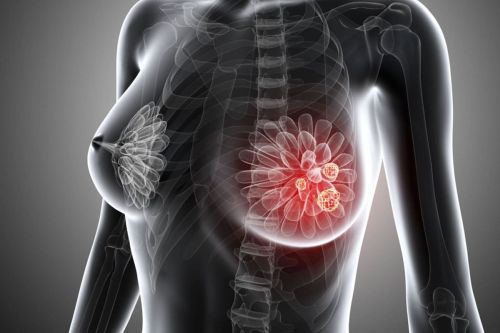Breast cancer is a type of cancer caused by the uncontrolled proliferation of cells in the breast tissue. It is usually noticed by a hard mass or an abnormal change in the breast. Although breast cancer is more common in women, it can also be seen in men. Early diagnosis increases the success of treatment. Treatment methods include surgery, chemotherapy, and radiotherapy. Risk factors include genetic predisposition and age.
What are the Symptoms of Breast Cancer?
 A painless hard lump felt in the breast or underarm is the most common symptom. Visible growth, shrinkage, or asymmetry in the breast may be noticeable. There may be a discharge from the nipple, usually bloody or yellowish. Retraction of the nipple or a change in the position of the nipple can be observed. Redness, thickening, orange peel appearance, or swelling of the breast skin may be noticed. Pain or tenderness in the breast or underarm, especially in the advanced stages, can be experienced. If any of these symptoms are noticed, it is important to see a doctor as soon as possible. Early diagnosis ensures successful results in the treatment of breast cancer.
A painless hard lump felt in the breast or underarm is the most common symptom. Visible growth, shrinkage, or asymmetry in the breast may be noticeable. There may be a discharge from the nipple, usually bloody or yellowish. Retraction of the nipple or a change in the position of the nipple can be observed. Redness, thickening, orange peel appearance, or swelling of the breast skin may be noticed. Pain or tenderness in the breast or underarm, especially in the advanced stages, can be experienced. If any of these symptoms are noticed, it is important to see a doctor as soon as possible. Early diagnosis ensures successful results in the treatment of breast cancer.
What Causes Breast Cancer?
 Mutations in certain genes, such as BRCA1 and BRCA2, significantly increase the risk. People with a family history of breast cancer are more likely to have these mutations. Long-term exposure to hormones such as estrogen and progesterone can increase the risk. Starting menstruation at an early age, late menopause, and hormone replacement therapy increase the risk. The risk also increases with age. Women over the age of 50 are particularly at higher risk. Factors such as obesity, unhealthy diet, alcohol consumption, smoking, and lack of physical activity increase the risk. Receiving radiation therapy to the chest area at a young age can increase the risk. Each of these factors can increase the likelihood of developing cancer. However, not every woman with these risk factors will develop breast cancer.
Mutations in certain genes, such as BRCA1 and BRCA2, significantly increase the risk. People with a family history of breast cancer are more likely to have these mutations. Long-term exposure to hormones such as estrogen and progesterone can increase the risk. Starting menstruation at an early age, late menopause, and hormone replacement therapy increase the risk. The risk also increases with age. Women over the age of 50 are particularly at higher risk. Factors such as obesity, unhealthy diet, alcohol consumption, smoking, and lack of physical activity increase the risk. Receiving radiation therapy to the chest area at a young age can increase the risk. Each of these factors can increase the likelihood of developing cancer. However, not every woman with these risk factors will develop breast cancer.
How is Breast Cancer Diagnosed?
 The doctor physically checks for lumps in the breast or underarm area. Mammography is the most commonly used imaging method for early diagnosis. The breast tissue is examined in detail using a low-dose X-ray. After mammography, a lump can be detected. In this case, ultrasound is used to determine whether the lumps are fluid-filled cysts or solid tumors. In cases where more detailed examination is required, MRI is used for women with dense breast tissue. For a definitive diagnosis of a suspicious lump, a biopsy is performed. During a biopsy, a small sample of breast tissue is taken and examined in the laboratory. Genetic predisposition tests, such as BRCA1 and BRCA2 gene mutations, are performed on individuals with a family history of breast cancer. These methods allow the detection of cancer at an early stage, which increases the chance of treatment.
The doctor physically checks for lumps in the breast or underarm area. Mammography is the most commonly used imaging method for early diagnosis. The breast tissue is examined in detail using a low-dose X-ray. After mammography, a lump can be detected. In this case, ultrasound is used to determine whether the lumps are fluid-filled cysts or solid tumors. In cases where more detailed examination is required, MRI is used for women with dense breast tissue. For a definitive diagnosis of a suspicious lump, a biopsy is performed. During a biopsy, a small sample of breast tissue is taken and examined in the laboratory. Genetic predisposition tests, such as BRCA1 and BRCA2 gene mutations, are performed on individuals with a family history of breast cancer. These methods allow the detection of cancer at an early stage, which increases the chance of treatment.
What are the Treatment Methods for Breast Cancer?
Lumpectomy is the removal of the cancerous area and surrounding tissue. It is done to preserve the breast. Mastectomy is a surgical method in which the entire breast is removed. Depending on the spread of the disease, a total or partial mastectomy may be performed. High-dose radiation is applied to destroy remaining cancer cells after surgery. It can be recommended after breast-conserving surgery or after a mastectomy. Chemotherapy is a drug treatment used to kill cancer cells. It can be administered before surgery (neoadjuvant) or after surgery (adjuvant). Hormone therapy is used to prevent the growth of cancer cells. It is effective in cancer types sensitive to hormones such as estrogen and progesterone. Targeted therapies focus on specific proteins that contribute to the growth of cancer cells. For example, the treatment used in HER2-positive breast cancer cases falls into this category. Immunotherapy strengthens the body's immune system and helps it fight cancer cells. It is usually used for advanced stages. These methods can be applied alone or in combination. The most appropriate treatment plan is determined by the doctor based on the patient's condition.


